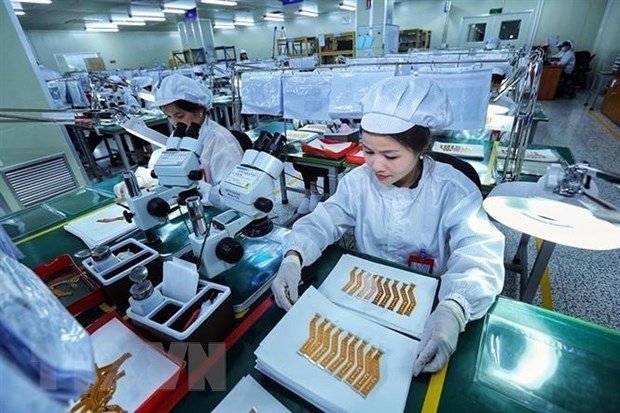 Economy
Economy

Việt Nam’s explosive growth is no secret, but investors may have to look a little closer to fully appreciate all the investment opportunities underlying the broader stories. Here, our expat financial expert Brian Spence dissects just a few.
50232202PM.JPG) |
| Brian Spence |
Việt Nam’s explosive growth is no secret, but investors may have to look a little closer to fully appreciate all the investment opportunities underlying the broader stories. Here, our expat financial expert Brian Spence dissects just a few.
As savvy money managers all over the world know, Việt Nam has a lot going for it as an investment prospect. The country’s Gross Domestic Product is growing strongly, along with its labour productivity; it has a young population noted for a “can-do” attitude; and it has a rapidly-expanding middle class with aspirations to a Western lifestyle and all the consumer trappings that entails.
What’s more, Việt Nam’s stock market has grown immensely since 2008, generating excellent returns on equity, while overseas investors are soon to be granted many more opportunities through privatisation and new-share flotations.
There is much to catch the eye when surveying Việt Nam’s growth story, but as an investor it always pays to understand the underlying thematic trends affecting the way people live and work. How you take a view on these will vary according to your individual investor profile, but I can see many possible investment opportunities here.
Two wheels to four
Where once the humble bicycle was the main mode of transport for the Vietnamese, car ownership is now booming, adding to the ubiquitous motorbikes and scooters that throng the streets. In HCM City alone, there are now thought to be over eight million motorbikes and some 600,000 cars registered across the city’s 13 million residents. And, car ownership levels are set to climb even higher in Việt Nam from this year after the Government’s expected move to cut tariffs on car imports – which will see motor prices slashed by close to half.
Việt Nam’s rapid shift from pedal power to petrol is causing unprecedented congestion which simply must be alleviated, however: the average commuter is thought to spend close to an hour battling the traffic daily, with HCM City suffering from up to 40 congestion hotspots and 130 simultaneous road works on any given day. Journey-makers in Hà Nội fare little better.
Laying the tracks for growth
Vast sums are being spent on road-building. But after tinkering with layouts and traffic restrictions – and even considering elevated roads – to reduce the immediate traffic pressure, the authorities have concluded that both cities must have metro systems like any other bustling metropolis in a high-growth country.
Hà Nội’s Cát Linh-Hà Đông line is set to be unveiled this year, with the completion of HCM City’s Bến Thành-Suối Tiên line expected in a couple of years. Running for 13km and 20km respectively, these are just the start of citywide networks which will get Việt Nam’s two largest cities really moving, boosting their economies – and those of the country – in multiple ways.
On the rails, as on the roads, Việt Nam’s massive infrastructure spending really is laying the tracks for growth across a huge array of industries and sectors.
Manufacturing the future
Having begun in labour-orientated manufacturing, Việt Nam has really forged ahead with technology-intensive sectors – with electronics leading the way. It may surprise Westerners (who tend to have quite an outdated perception of the country) to learn that Việt Nam is ranked 18 among the world’s fastest-growing electronic exporters (high-tech products contributed almost 29 per cent of the country’s GDP as far back as 2013).
Low labour costs are of course a big part of Việt Nam’s success in manufacturing – which is why China, the US and Japan have offshored manufacturing here for many years.
However, Việt Nam is also pressing on with real innovation. In May last year, Việt Nam’s Prime Minister called on the country to embrace disruptive technologies to further bolster its manufacturing sector. Among other innovations on the agenda is the combination of automation, robotics and the “Internet of Things”, to ramp up efficiency and lower production costs (IoT leverages smart sensors and big data analytics to make machines “smart”).
In short, Việt Nam is hot on the heels of technology front-runners Japan and Singapore, and there may be immense value in getting in early on the country’s pioneers.
Opportunities abound
While this column is not the place for making specific recommendations, what I can recommend is a closer look at the drivers behind Việt Nam’s incredible growth story and all the myriad investment opportunities they might bring.
Việt Nam has come a long way since its tentative emergence as a market-driven economy, but the country’s stellar rise still has a very long way to go in my view. Whatever kind of investor you are, make sure you understand the offshoot growth stories stemming from the larger ones – that’s often where the real return potential lies. — VNS
* Brian Spence is Managing Partner of S&P Investments. He has over 35 years’ experience in the UK financial services industry as an investment manager, financial planner, and M&A specialist. He is a regular contributor in the UK financial press and has a deep understanding of the financial services community. Brian’s column will reflect on all the challenges and opportunities within the Vietnamese market, bringing a fresh perspective to today’s hottest issues. The columnist’s email is brian@sandpinvestments.com.









